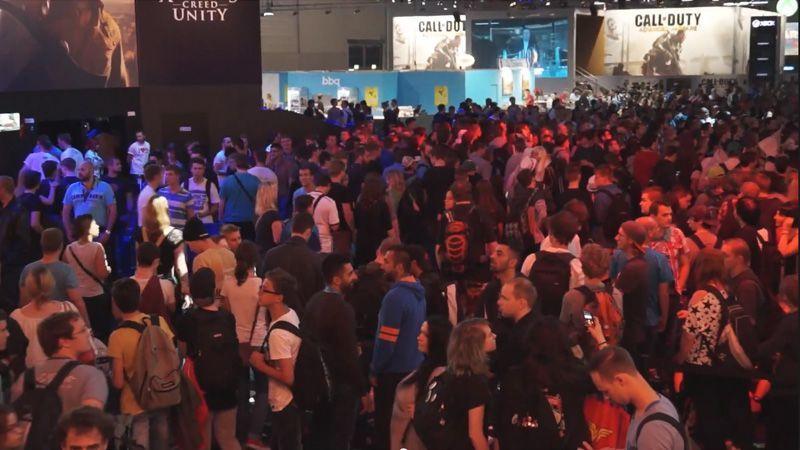Gamescom & Fluffy Puppies
Travelling from Cologne to Frankfurt via high-speed rail is one of the most pleasant things a human being can do. A comparable experience would be being plopped on a bed of feathers and covered in golden retriever puppies. To anyone that has grown up in a part of the world without brilliant trains, that is to say most of us, the German ICE is a revelation.
Everything about the journey is delightful. The train pulls gently and quietly into the station at precisely the scheduled moment, panels on the carriages display numbers corresponding to one's ticket, and little steps deploy outwards from the base of the doors to ease ingress.
Inside, doors open with a woosh when approached. The attention to detail is brilliant. For example, the route information display is covered in semi-reflective glass that makes the whole panel look like something out of the future.
At the front of the train, it is even possible to see straight through a floor-to-ceiling glass panel into the driver's cabin, and on to the tracks ahead. The whole setup makes the Eurostar look a bit dour, the Thalys gaudy, and the TGV clunky.
The company responsible for putting together this slick piece of kit is Siemens AG. Since building the original ICE 3 'Velaro' for DBahn in Germany, Siemens has inked deals to export the train to China, Russia, Spain, the Netherlands, Turkey, and Eurostar International Ltd.
Siemens has made itself very good at building high-speed rail train sets, and as a result it is selling lots of them. Which brings me to the process of making games. The purpose of my recent trip on the ICE was to escape Gamescom.
Gamescom is a truly superlative experience. For reference, PAX East, another major gaming event, occupies 19,100 square metres of show floor space in Seattle. Gamescom occupies 284,000m², excluding transit halls and outdoor eating areas. To put that in perspective, the entire PAX East show floor would fit inside just one of Gamescom's halls, the biggest of which occupies 22,332m².
httpv://www.youtube.com/watch?v=2he0fJ64pV8&list=UUikjPYSpgq4nhy9THhALSjg
All that space means lots of games. And as one walks through the space, it becomes rapidly apparent that there are lots of people on this planet trying to make train sets - And many of them are very good at it. To sell lots of trains, a game developer needs to think carefully about what kind of train to make, lest they accidentally try to take on Siemens in the high-speed rail space.
Walking the Gamescom floor, there are several themes: There are incredible trailers everywhere, astounding graphics abound, press schmoozing is ubiquitous, and the spectacle is universally extreme. Attempting to differentiate a product on the basis of any of those points is a high-risk strategy, because so many developers are doing it so well.
What Gamescom teaches the observant attendee is that to sell lots of trains, a game developer needs to identify their competitive advantage, and pursue it ruthlessly. A developer may assign resources to many aspects of a game - A successful one will assign those resources where they have the advantage over everyone else.
I don't know what it is about Siemens AG that makes it so good at building high-speed rail train sets, but that doesn't really matter: What matters is what makes Unknown Worlds good at making games. What is our competitive advantage? What can possibly make our product stand out, and not on the Gamescom show floor, but the much bigger floor that the Koelnmesse represents: The games market as a whole.
Little examples of the pursuit of competitive advantage abound. DayZ has terrible animations, Titanfall terrible textures, Call of Duty simple mechanics, Civ5 hair-pulling multiplayer, and so forth. None of them care, as they laugh all the way to the bank. For Bohemia Interactive to re-allocate resources away from inventive, iterative gameplay mechanics in DayZ towards improved animations would be a huge mistake, and so forth.
Historically, Unknown Worlds has had several competitive advantages. We are capable of creating our own flexible and capable game engines and associated technology, balancing hyper-complex competitive multiplayer, attracting attention through open communication, keeping costs low by maintaining small team sizes, achieving high quality graphics, presenting unique and compelling art styles, and being responsive to the needs of a global, not just English-speaking audience, by operating as a globally distributed and culturally diverse team.
We also have disadvantages. Our games tend to perform poorly on lower end hardware, we are pathologically incapable of sticking to deadlines, developments suffer from massive feature creep, global team communication is often patchy, team gender diversity is atrocious, formal press-facing public relations mechanisms are virtually non-existent, and decisions are too-often made by intuition rather than investigation.
Siemens AG is not perfect either. While it is a highly successful in the high-speed rail, competitors have arguably beaten it in slower and higher speed configurations in many markets. Siemens has advantages, and disadvantages. The same is true for everyone on the Gamescom show floor, and across the whole game development space. Everyone has strengths and weaknesses.
It is crucial that Unknown Worlds, and any game developer, consider where their competitive advantage lies and pursue it ruthlessly. If we don't, if we try to fight Siemens in the high-speed rail space, then we are taking on huge risk. Either we must very clearly consider why we think we can build a better product than the ICE 3 Velaro, or must build games that express our advantages - And in so doing, delight customers in ways that our competitors cannot.
- Hugh








